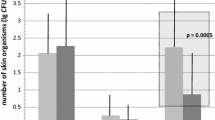Abstract
The potential route of contamination by skin microorganisms onto the distal tip of central venous catheters during insertion was investigated. Thirty patients undergoing cardiac surgery who required a central venous catheter (CVC) as part of their clinical management were studied. Following catheter placement, the device insertion equipment and the skin at the insertion site were sampled for microorganisms. The distal tips of the CVCs were also sampled in situ within 90 min post insertion. Bacteria were isolated from 20 of 30 (66%) CVC skin insertion sites, from 15 of 30 (50%) guidewires, and from five of 30 (16%) catheter distal tips in situ. These findings suggest that despite rigorous skin disinfection and strict aseptic technique, viable microorganisms are impacted during insertion onto the distal tip of the CVC, which may act as a subsequent nidus of infection.
Similar content being viewed by others
References
Elliott TSJ: Intra-vascular-device infections. Journal of Medical Microbiology 1988, 27: 161–167.
Elliott TSJ: Line associated bacteraemias. Communicable Diseases Report 1993, 3: 91–95.
Maki DG, Goldman DA, Rhame FS: Infection control in intravenous therapy. Annals of Internal Medicine 1973, 79: 867–887.
Sitges-Serra A, Puig P, Linares J, Perez JL, Farrero N, Jaurrieta E, Garau J: Hub colonisation as the initial step in an outbreak of catheter-related sepsis due to coagulase-negative staphylococci during parenteral nutrition. Journal of Parenteral and Enteral Nutrition 1984, 8: 668–672.
Williamson P, Kligman AM: A new method for the quantitative investigation of cutaneous bacteria. Journal of Investigative Dermatology 1969, 45: 498–503.
Chawner JA, Gilbert P: A comparative study of the bactericidal and growth inhibitory activities of the bisbiquanides alexidine and chlorhexidine. Journal of Applied Bacteriology 1989, 66: 243–252.
Maki DG, Weise CE, Sarafin HW: A semi-quantitative culture method for identifying intravenous catheter-related infection. New England Journal of Medicine 1977, 296: 1305–1309.
Crocker IC, Liu WK, Byrne PO, Elliott TSJ: A novel electrical method for the prevention of microbial colonisation of intravascular cannulae. Journal of Hospital Infection 1992, 22: 7–17.
Tebbs SE, Elliott TSJ: A novel antimicrobial central venous catheter impregnated with benzalkonium chloride. Journal of Antimicrobial Chemotherapy 1993, 31: 261–271.
Author information
Authors and Affiliations
Rights and permissions
About this article
Cite this article
Elliott, T.S.J., Moss, H.A., Tebbs, S.E. et al. Novel approach to investigate a source of microbial contamination of central venous catheters. Eur. J. Clin. Microbiol. Infect. Dis. 16, 210–213 (1997). https://doi.org/10.1007/BF01709583
Issue Date:
DOI: https://doi.org/10.1007/BF01709583




